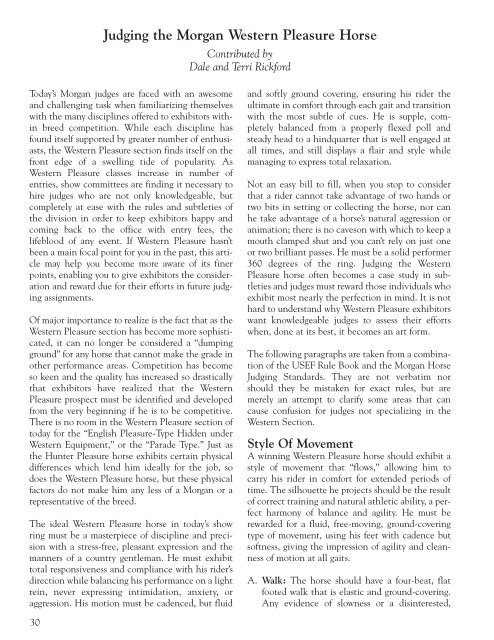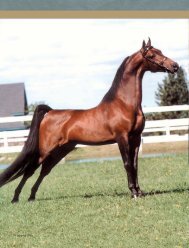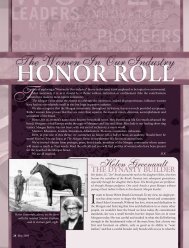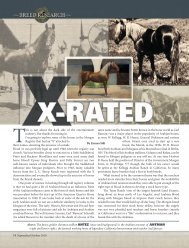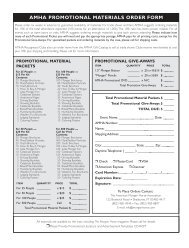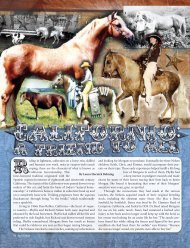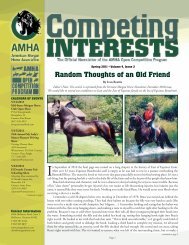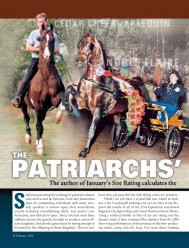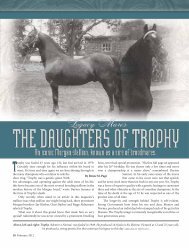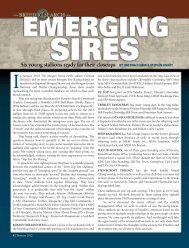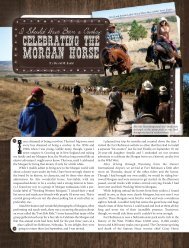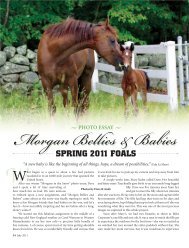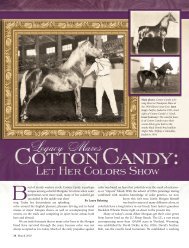Judging School Handbook - American Morgan Horse Association
Judging School Handbook - American Morgan Horse Association
Judging School Handbook - American Morgan Horse Association
Create successful ePaper yourself
Turn your PDF publications into a flip-book with our unique Google optimized e-Paper software.
<strong>Judging</strong> the <strong>Morgan</strong> Western Pleasure <strong>Horse</strong>Contributed byDale and Terri RickfordToday’s <strong>Morgan</strong> judges are faced with an awesomeand challenging task when familiarizing themselveswith the many disciplines offered to exhibitors withinbreed competition. While each discipline hasfound itself supported by greater number of enthusiasts,the Western Pleasure section finds itself on thefront edge of a swelling tide of popularity. AsWestern Pleasure classes increase in number ofentries, show committees are finding it necessary tohire judges who are not only knowledgeable, butcompletely at ease with the rules and subtleties ofthe division in order to keep exhibitors happy andcoming back to the office with entry fees, thelifeblood of any event. If Western Pleasure hasn’tbeen a main focal point for you in the past, this articlemay help you become more aware of its finerpoints, enabling you to give exhibitors the considerationand reward due for their efforts in future judgingassignments.Of major importance to realize is the fact that as theWestern Pleasure section has become more sophisticated,it can no longer be considered a “dumpingground” for any horse that cannot make the grade inother performance areas. Competition has becomeso keen and the quality has increased so drasticallythat exhibitors have realized that the WesternPleasure prospect must be identified and developedfrom the very beginning if he is to be competitive.There is no room in the Western Pleasure section oftoday for the “English Pleasure-Type Hidden underWestern Equipment,” or the “Parade Type.” Just asthe Hunter Pleasure horse exhibits certain physicaldifferences which lend him ideally for the job, sodoes the Western Pleasure horse, but these physicalfactors do not make him any less of a <strong>Morgan</strong> or arepresentative of the breed.The ideal Western Pleasure horse in today’s showring must be a masterpiece of discipline and precisionwith a stress-free, pleasant expression and themanners of a country gentleman. He must exhibittotal responsiveness and compliance with his rider’sdirection while balancing his performance on a lightrein, never expressing intimidation, anxiety, oraggression. His motion must be cadenced, but fluidand softly ground covering, ensuring his rider theultimate in comfort through each gait and transitionwith the most subtle of cues. He is supple, completelybalanced from a properly flexed poll andsteady head to a hindquarter that is well engaged atall times, and still displays a flair and style whilemanaging to express total relaxation.Not an easy bill to fill, when you stop to considerthat a rider cannot take advantage of two hands ortwo bits in setting or collecting the horse, nor canhe take advantage of a horse’s natural aggression oranimation; there is no caveson with which to keep amouth clamped shut and you can’t rely on just oneor two brilliant passes. He must be a solid performer360 degrees of the ring. <strong>Judging</strong> the WesternPleasure horse often becomes a case study in subtletiesand judges must reward those individuals whoexhibit most nearly the perfection in mind. It is nothard to understand why Western Pleasure exhibitorswant knowledgeable judges to assess their effortswhen, done at its best, it becomes an art form.The following paragraphs are taken from a combinationof the USEF Rule Book and the <strong>Morgan</strong> <strong>Horse</strong><strong>Judging</strong> Standards. They are not verbatim norshould they be mistaken for exact rules, but aremerely an attempt to clarify some areas that cancause confusion for judges not specializing in theWestern Section.Style Of MovementA winning Western Pleasure horse should exhibit astyle of movement that “flows,” allowing him tocarry his rider in comfort for extended periods oftime. The silhouette he projects should be the resultof correct training and natural athletic ability, a perfectharmony of balance and agility. He must berewarded for a fluid, free-moving, ground-coveringtype of movement, using his feet with cadence butsoftness, giving the impression of agility and cleannessof motion at all gaits.A. Walk: The horse should have a four-beat, flatfooted walk that is elastic and ground-covering.Any evidence of slowness or a disinterested,30


